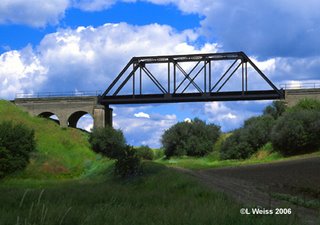Late to the Party
 When the decision was made to push the large, but modest, Midwestern line known as The Chicago, Milwaukee, and St. Paul Railroad to the northwest the year was 1905. Already 22 years after the Northern Pacific had driven its golden spike at Gold Creek, MT. Still, the railroad looked at its Western Extension with optimism, electing to electrify large sections of its line across the mountains to the west.
When the decision was made to push the large, but modest, Midwestern line known as The Chicago, Milwaukee, and St. Paul Railroad to the northwest the year was 1905. Already 22 years after the Northern Pacific had driven its golden spike at Gold Creek, MT. Still, the railroad looked at its Western Extension with optimism, electing to electrify large sections of its line across the mountains to the west.Still, despite this optimism, it's hard to argue the Milwaukee wasn't late to the party. While some of its extension tapped the fertile wheat fields of central Montana (and over time these central Montana lines would prove to be its most profitable of the entire extension), most of the extension entered into environments already well developed with rails. In the wheat fields of Eastern Washington this scenario was played out with the NP and UP both vying for supremacy among the rolling hills of The Palouse. Secondary players contributed to the juggernaut of rails that encompassed the region as well. The small interurban named the Spokane and Inland Empire built lines south from Spokane to Colfax, WA and Moscow, ID. As the little interurban entered financial hardship, the mighty GN supported it, making The Palouse a virtual battleground of the large western railroads. This was the environment The Milwaukee entered as it raced to the Pacific. The older lines had the region gripped in a power struggle whereas The Milwaukee built a mainline that bypassed Spokane, the region's largest city (the Milwaukee would later rectify this via trackage rights over the Union Pacific).
Today, many many years beyond the economics of 1905, evidence of this old regional conflict can still be seen out among the hills of The Palouse. The bold and expensive bridge of America's final transcon still lofts itself over the old SIE at Seabury, WA. History has been kind to neither and both stand silently, a generation beyond their last trains. Like so many other places that are off the beaten paths, Seabury has a fascinating story; it looks back to an era when egos were laid across the landscape in ribbons of steel and the Milwaukee Road was late to the party.



Comments